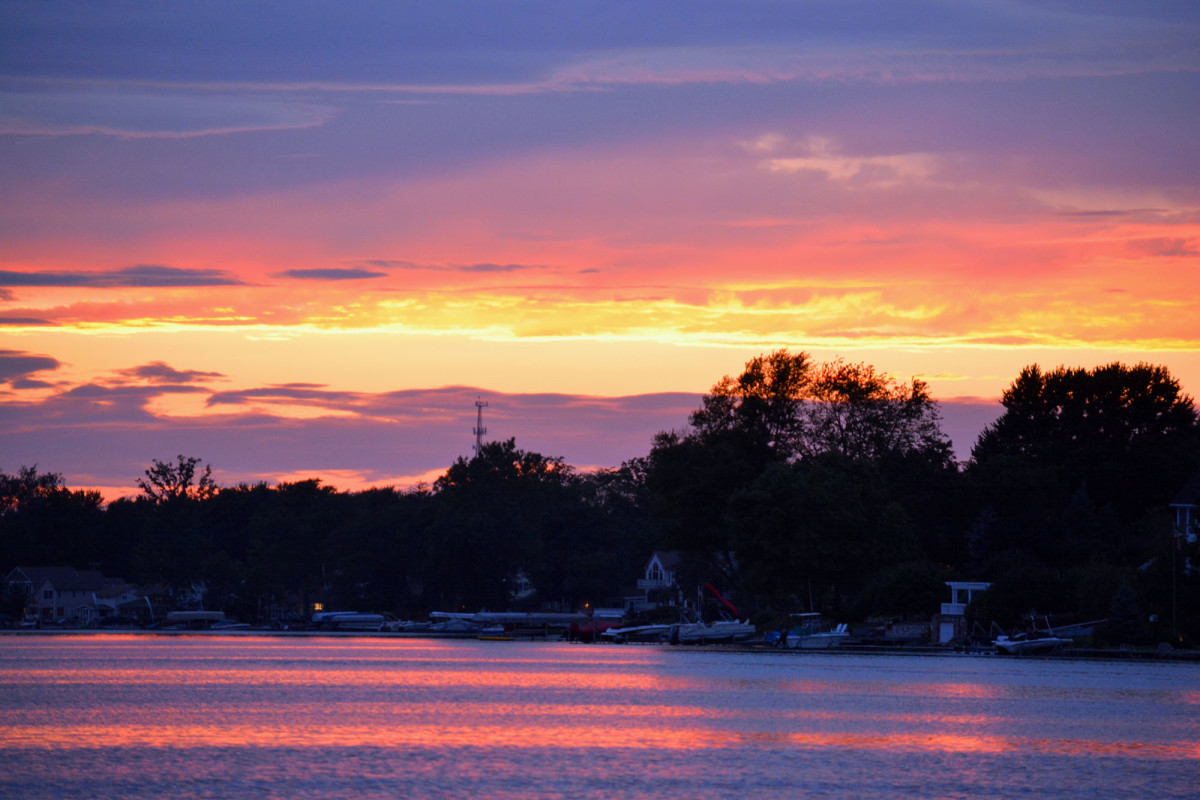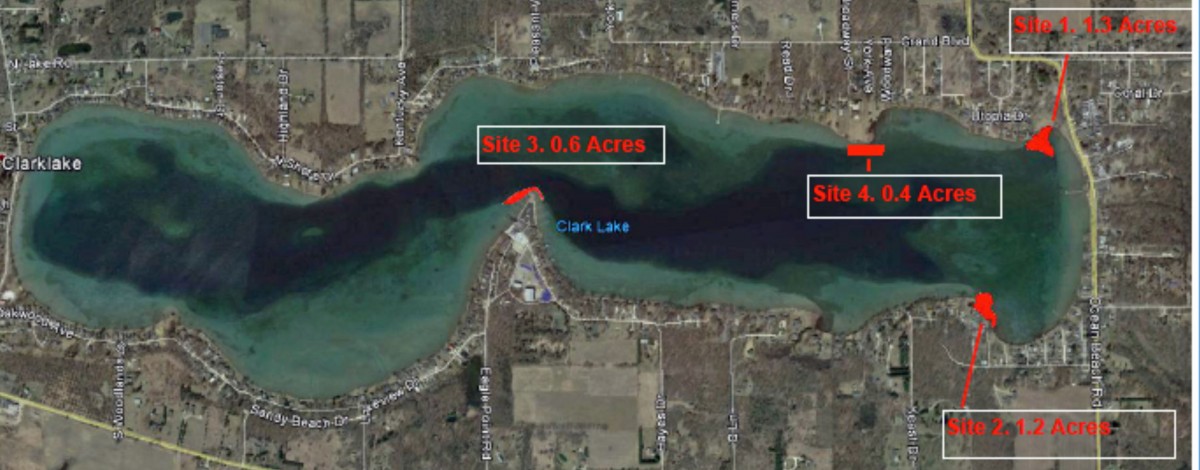 Two notable events took place Monday evening–another awesome sunset and a vote by the Columbia Township Board of Trustees about something at Clark Lake that is not so beautiful. All six members of the board present voted to take the next step in establishing a special assessment district (SAD) to deal with invasive weeds in Clark Lake. Tonight’s vote schedules a public hearing on August 11 and provides for notifying property owners of the meeting via ads in the Exponent and directly by U.S. Mail.
Two notable events took place Monday evening–another awesome sunset and a vote by the Columbia Township Board of Trustees about something at Clark Lake that is not so beautiful. All six members of the board present voted to take the next step in establishing a special assessment district (SAD) to deal with invasive weeds in Clark Lake. Tonight’s vote schedules a public hearing on August 11 and provides for notifying property owners of the meeting via ads in the Exponent and directly by U.S. Mail.
The not-beautiful news is that Clark Lake is battling hybrid Eurasian water milfoil (HEWM). DNA testing confirmed its presence in the lake and a survey revealed an infestation of about 20 acres. Other lakes that didn’t act found that it curtailed recreational use of their lake, destroyed wildlife habitat and negatively affected property values.
Just over 4 acres of Clark Lake’s infestation were treated on June 18th by a licensed professional applicator. An initial survey of results suggests that the treatment worked well.
DEQ permits and permission of property owners in the area of treatment were required. The HEWM is far more widespread in Clark Lake than the 4 acres just treated. Because of limits on the ability of property owners to give permission beyond 250 feet of their shoreline, the Clark Lake Invasive Species Committee conducted a petition drive to establish an special assessment district (SAD). The SAD will allow for treatment anywhere in the lake where the HEWM is found and also support the effort through an assessment.
Ron June address the Columbia Township board on behalf of the Clark Lake Invasive Species Committee. Here is the text of the message:
“Clark Lake is threatened by an aquatic invasive species known as hybrid Eurasian water milfoil, abbreviated as HEWM. DNA testing has confirmed its presence in the lake. A survey last fall, supported by the Clark Lake Spirit Foundation, revealed that there was 20 acres in the lake. This weed propagates rapidly. A small piece of plant that drifts to a new location can start an entirely new colony. On the Clark Lake Spirit website, there are before and after aerial photos showing how quickly it took root near the County Park. Other photos illustrate its density. HEWM grows in waters up to 20 feet deep, right up to the shoreline. Other lakes in the region that did not check its advance found that it curtailed recreational use of their waters, destroyed wildlife habitat, and was detrimental to property values. Before a treatment program at Grass Lake began, a witness reported seeing a muskrat walking on top of the weeds where before there was open water.
“The Committee researched the problem extensively and believes that the only way to halt this invasion is through application of approved herbicides by professionals. Because of the limitation of riparian rights and the cost of ongoing treatment, the Committee is convinced that it is necessary to establish a special assessment district or SAD under Michigan Public Act 188 of 1954, as amended.
“In taking the SAD concept to residents, the committee found overwhelming support. 95% of lakefront property owners contacted by the Committee signed the SAD petition, the format of which was approved by Columbia Township. The Committee has presented to the Township petitions attesting the agreement of nearly 74% of lakefront property owners, based on their lakefront footage.
“Gathering these petitions represents hundreds of man-hours from a team of volunteers who are part of the Clark Lake community. Along with the many who signed the petition, the volunteers are evidence of widespread support to establish the SAD.
“Time is of the essence. By next summer, it’s estimated that the Clark Lake HEWM population will have covered 25 acres. That’s in spite of a privately funded program that eradicated a little over 4 acres this spring. The Committee believes that the SAD must be in operation so the assessments can be part of the Winter 2015 tax bills, and that treatment of the HEWM can commence in Spring 2016 to any area of the lake where the weed is detected.
“The Committee has presented to the Township its formal plan and budget projections for the 7 year life of the SAD. That plan included a pamphlet that the Committee has handed out to residents that answers commonly asked questions. The results of many hours of research can be found at clarklakespirit dot com under invasive weeds.
“On behalf of an overwhelming majority of owners of Clark Lake frontage, we ask for your continued support in setting up the two public hearings and making arrangements for the required notices in the Exponent and via First Class U.S. Mail.
Ron June thanked the board.
HEWM is different from the native milfoil plant found in Clark Lake. HEWM is the fast spreading hybrid and can be identified by its reddish stem. After busy weekends, you can find patches of it floating in the lake. These floaters were likely created by props chopping off the tops of the plants. The bad news is that each one of those clippings is capable of starting many more of its genre. The good news is that the treatment program works. And then there are the sunsets–one of the things that make being at Clark Lake so worthwhile.

Columbia Township trustees meeting on July 20, 2015. Left to right: Rick Deland, Flip Reynolds, John Calhoun (treasurer), Bob Elrod (supervisor), C.J. Hulburt (deputy clerk), Robin Tackett, Brent Beamish












